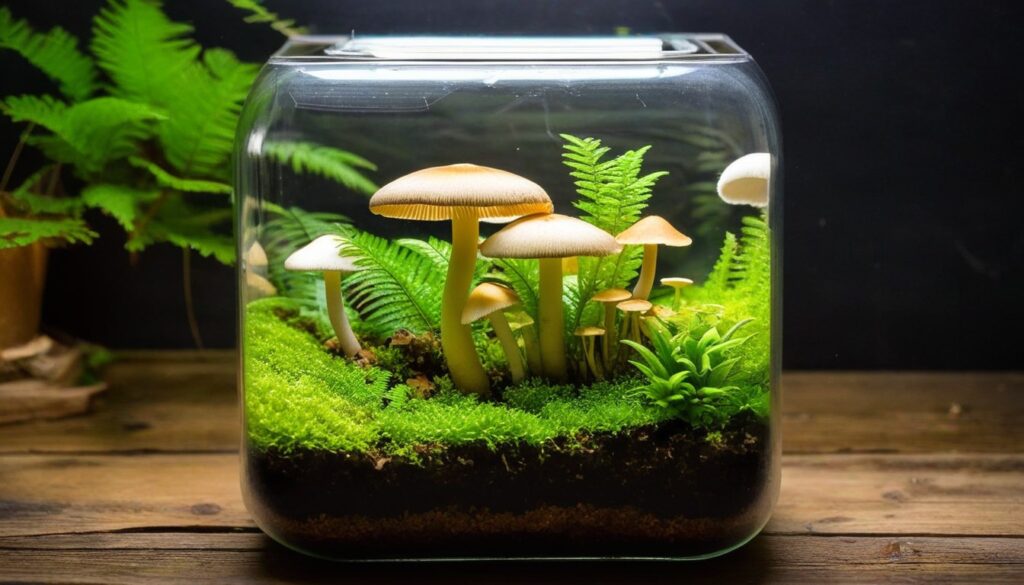Are you an indoor gardening enthusiast looking for a new challenge? Growing mushrooms in a terrarium can be a fascinating and rewarding experience. Not only will you be able to enjoy the fruits of your labor, but you’ll also learn about the intricate world of fungi and their role in our ecosystem.
In this comprehensive guide, we’ll walk you through the process of growing mushrooms in a terrarium. Whether you’re a seasoned gardener or a beginner, we’ll provide detailed instructions and tips to help you achieve successful mushroom cultivation in the comfort of your own home.
Key Takeaways
- Learn how to grow mushrooms in a terrarium for a rewarding indoor gardening experience.
- Follow our step-by-step guide for successful mushroom cultivation.
- Choose the right terrarium and mushroom species for optimal growth.
- Ensure the perfect growing environment by controlling temperature, humidity, and ventilation.
- Harvest and enjoy your homegrown mushrooms with our expert tips.
Choosing the Right Terrarium for Mushroom Cultivation
If you’re planning to grow mushrooms in a terrarium, the first step is selecting the right type of terrarium. There are different types of terrariums available, and choosing the best one for your mushroom cultivation project is crucial to its success.
When selecting a terrarium, consider the following:
- Size: Choose a terrarium that is large enough to accommodate your mushroom species and allow for proper air circulation.
- Material: Terrariums can be made from glass, plastic, or acrylic. Glass is the most common and offers better insulation, while plastic or acrylic is lightweight and shatterproof.
- Shape: Terrariums come in different shapes, such as rectangular or spherical. Choose a shape that suits your needs and allows for proper lighting and airflow.
Once you’ve selected a terrarium, ensure that it’s thoroughly cleaned and sterilized before use. This will help prevent contamination and ensure a healthy growing environment for your mushrooms.
Pro tip: Consider purchasing a terrarium kit that includes all the necessary components, such as lighting and ventilation, for optimal mushroom cultivation.
Selecting the Ideal Mushroom Species for your Terrarium
Choosing the right mushroom species is crucial for successful terrarium cultivation. Not all mushroom species are suited for indoor growing, and each has specific requirements for growth.
Some of the most suitable mushroom species for terrarium cultivation include:
|
Mushroom Species |
Optimal Temperature Range |
Humidity Requirements |
Lighting Needs |
|---|---|---|---|
|
Shiitake |
50-80°F |
80-85% |
Low light |
|
Oyster |
65-75°F |
75-85% |
Low to medium light |
|
Lion’s Mane |
60-75°F |
85-95% |
Low to medium light |
When selecting a mushroom species, it’s essential to consider the temperature and humidity requirements and lighting needs. Choose a species that is well-suited for the environment you can provide in your terrarium.
Additionally, it’s important to purchase high-quality mushroom spawn from a reputable source to ensure optimal growth. Avoid purchasing spores or spawn kits from unknown sources, as they may be contaminated or produce low-quality mushrooms.
Creating the Perfect Growing Environment in your Terrarium
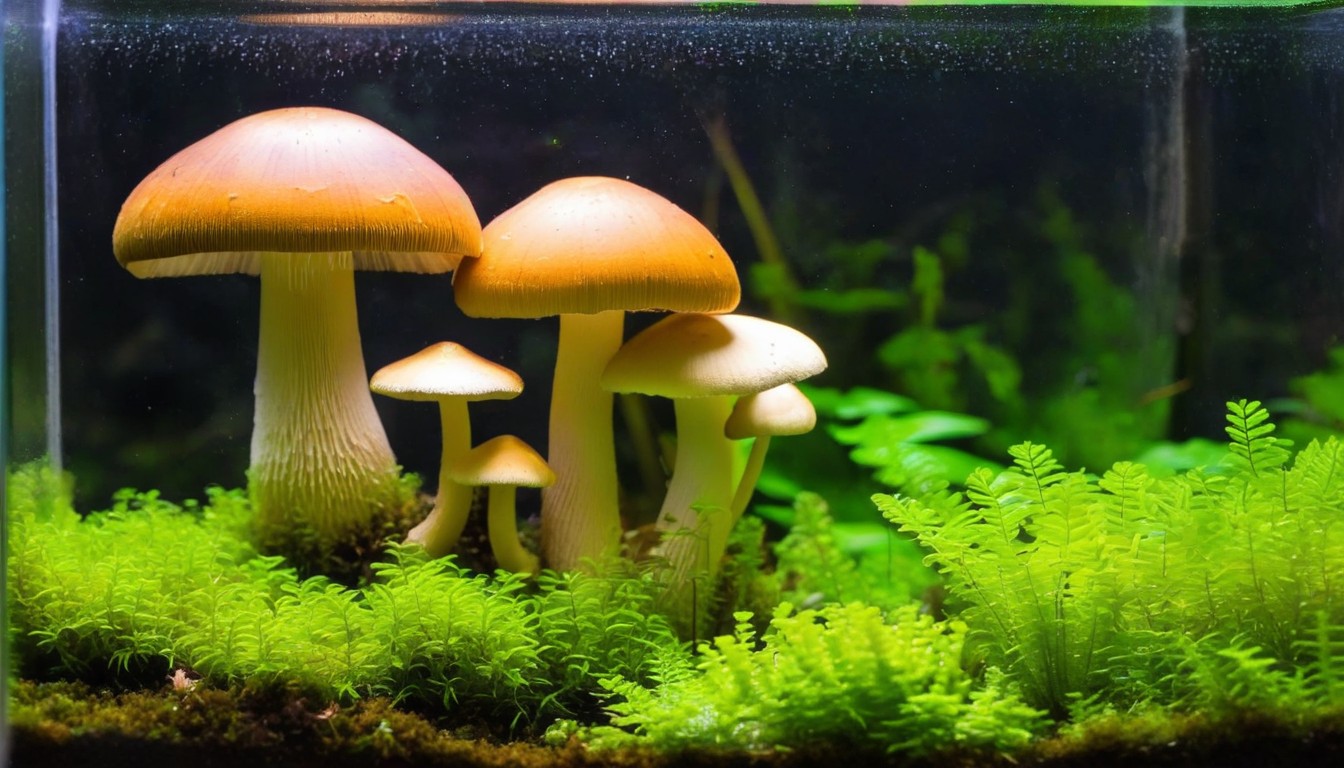
Creating the perfect growing environment in your terrarium is critical to the success of your mushroom cultivation project. The ideal growing conditions include:
|
Growing Condition |
Ideal Range |
|---|---|
|
Temperature |
60-70°F |
|
Humidity |
90-95% |
|
Ventilation |
Regular air exchange |
It’s essential to maintain the appropriate temperature and humidity levels for your mushroom species to thrive. You can use a thermometer and hygrometer to monitor the conditions inside your terrarium.
Ventilation is also vital to prevent the buildup of carbon dioxide, which can harm your mushrooms. You can achieve proper ventilation by opening the terrarium lid for a few minutes each day or installing a fan to circulate the air.
Other factors to consider when creating the perfect growing environment include:
- Lighting: Your mushroom species may require specific lighting conditions, so it’s essential to research their needs.
- Cleanliness: A clean environment is crucial to prevent the growth of contaminants that can harm your mushrooms.
With the proper growing conditions, your mushroom terrarium will thrive, and you’ll soon be enjoying your very own homegrown mushrooms in no time!
Preparing the Substrate for Mushroom Cultivation
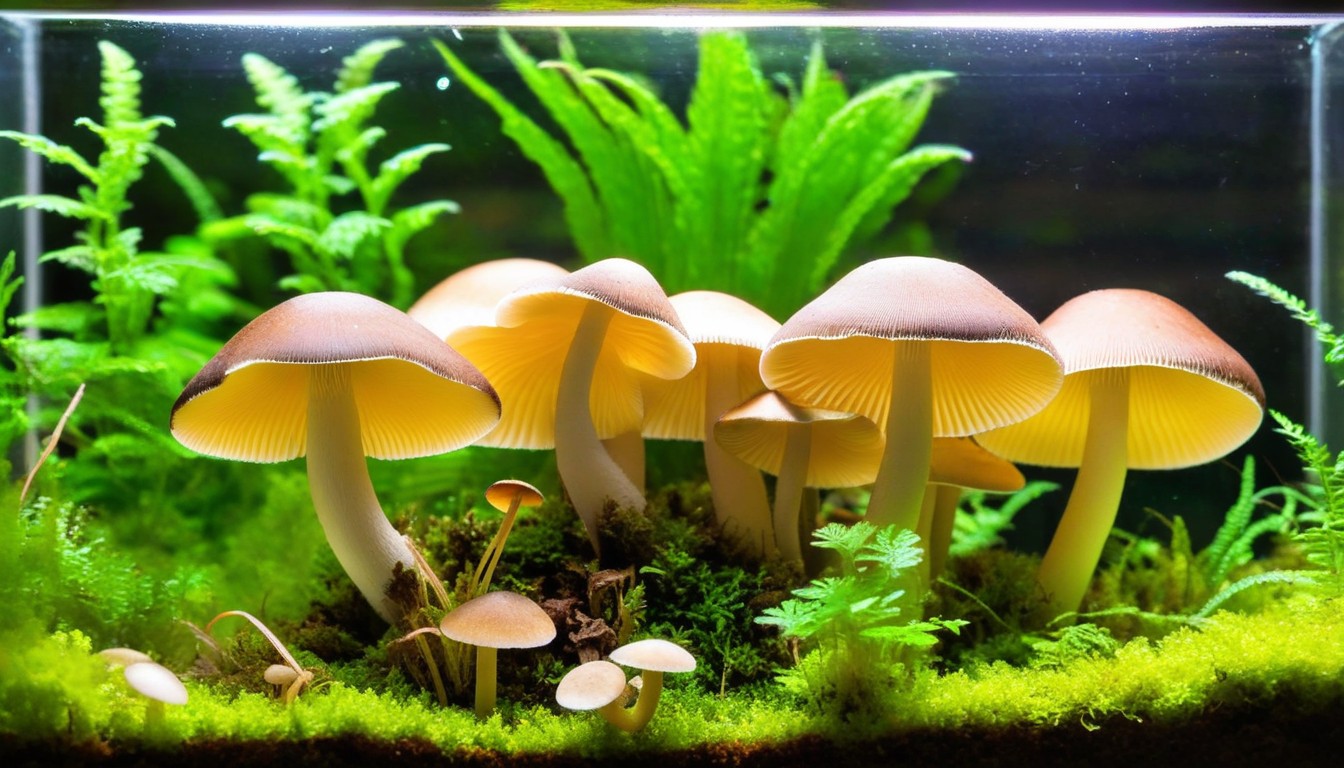
One of the most crucial aspects of successful mushroom cultivation in a terrarium is preparing the substrate. The substrate is the material that provides nutrients for the mushrooms to grow. It’s essential to use the right type of substrate and prepare it properly to ensure a healthy growing medium for your mushrooms.
Choosing the Right Substrate for Your Mushroom Species
The type of substrate you use will depend on the specific species of mushroom you’re growing. Different mushroom species have different nutritional requirements, so it’s important to research the ideal substrate for your particular mushroom.
Some common substrates used in mushroom cultivation include:
|
Substrate Material |
Advantages |
Disadvantages |
|---|---|---|
|
Straw |
Readily available, low cost |
Difficult to sterilize, prone to contamination |
|
Sawdust |
Easy to prepare, high yield |
May require additional nutrients |
|
Coffee Grounds |
Readily available, high yield |
May require additional nutrients, prone to contamination |
Remember to always sterilize your substrate before use to prevent contamination. You can use a pressure cooker, an autoclave, or steam sterilization to sterilize your substrate.
Preparing Your Substrate
Once you’ve selected your substrate, it’s time to prepare it for mushroom cultivation. Follow these steps:
- Chop the substrate into small pieces to increase its surface area.
- Add enough water to the substrate to make it damp but not wet.
- Place the substrate in a container and cover it with foil.
- Steam the substrate for at least 30 minutes to kill any bacteria or fungi present.
- Allow the substrate to cool completely before inoculating it with mushroom spores.
When preparing your substrate, choose a well-ventilated area and wear gloves and a face mask to prevent inhaling any harmful substances.
By properly preparing your substrate, you can create the ideal growing medium for your mushrooms and increase your chances of a successful harvest. Remember to research the specific substrate requirements for your chosen mushroom species and always sterilize your substrate before use.
Inoculating the Terrarium with Mushroom Spores
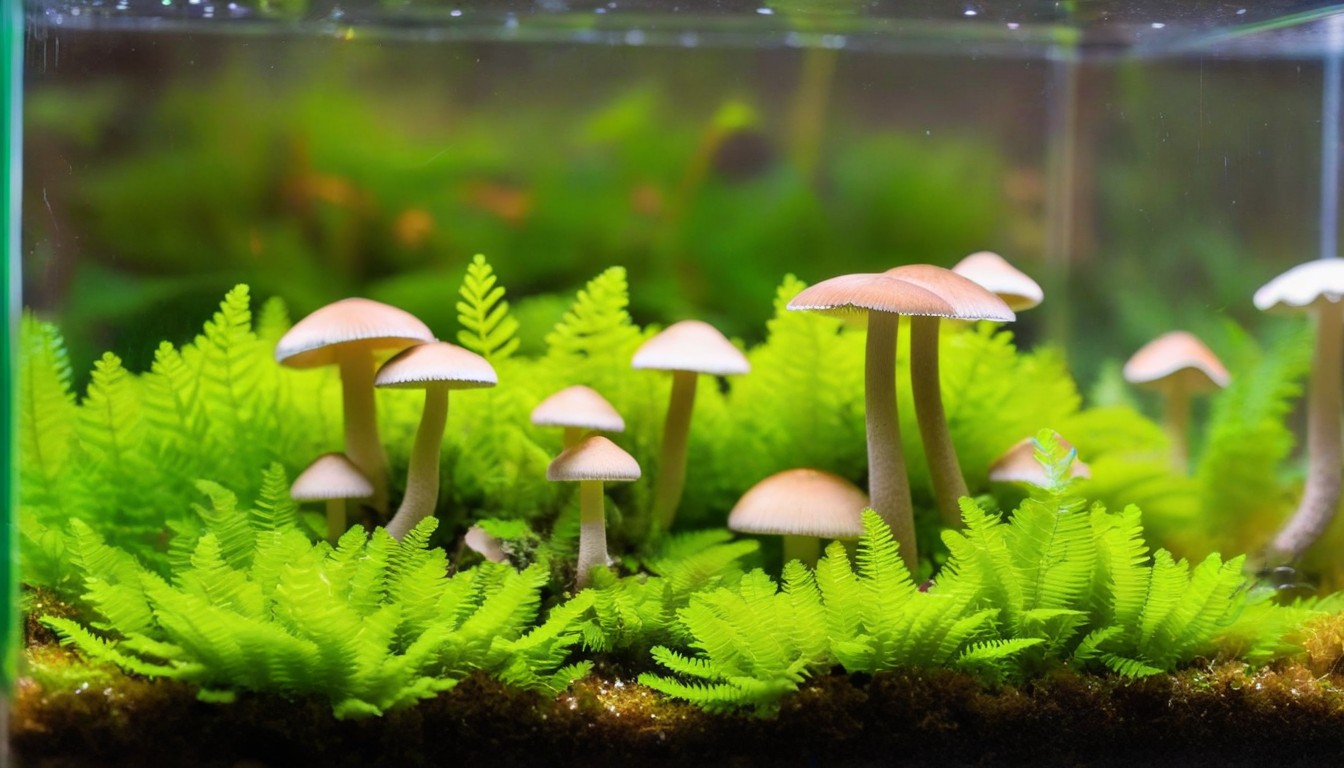
Now that you have prepared the substrate, it’s time to inoculate your terrarium with mushroom spores. Inoculation is the process of introducing mushroom spores into the substrate, where they will grow and colonize the growing medium.
There are several methods of inoculation, including:
- Pre-made spawn: This is a pre-inoculated substrate that is added to your growing medium.
- Spore syringe: This is a syringe filled with mushroom spores that are injected into the substrate.
- Spore print: This is a spore deposit that is transferred onto the substrate using a sterile technique.
Regardless of the method you choose, it’s essential to ensure that the inoculation process is done in a sterile environment to prevent contamination. Dust, bacteria, and other organisms can hinder the growth of your mushrooms and ruin your entire crop.
Here are some general steps to follow when inoculating your terrarium with mushroom spores:
- Sterilize the area and your tools to ensure proper cleanliness.
- Carefully inject or sprinkle the spores onto the substrate.
- Close the terrarium and allow the spores to colonize the growing medium.
The colonization process can take anywhere from a few days to a few weeks, depending on the type of mushroom species and the environmental conditions. Be patient and monitor the growth regularly. You will see small white patches forming on the surface of the substrate, indicating that the mycelium is growing and spreading.
Remember to maintain the necessary environmental conditions during the colonization process. Proper temperature, humidity, and ventilation are crucial for optimal growth.
Tip: Label your terrarium with the date of inoculation and the type of mushroom species. This will help you keep track of the progress and identify any issues that arise during the cultivation process.
Inoculating your terrarium with mushroom spores is a crucial step in the cultivation process. With the right tools and techniques, you can ensure successful colonization and a healthy mushroom crop.
Maintaining and Caring for your Mushroom Terrarium
Congratulations! Your mushroom terrarium is now fully established, and your mushrooms are starting to grow. However, to ensure the healthy growth of your mushrooms, it’s essential to maintain and care for your terrarium properly.
Watering your mushroom terrarium is critical, as mushrooms require high levels of humidity to grow successfully. Use a spray bottle to mist the inside of your terrarium regularly. Avoid over-watering the substrate, as this can lead to contamination or stunted mushroom growth.
Monitoring your terrarium is also essential to identify any potential issues that may arise. Regularly inspect your substrate for any signs of contamination or pests. If you notice anything unusual, take immediate action to prevent the issue from worsening.
In addition to monitoring, it’s crucial to provide proper ventilation to your mushroom terrarium. Proper ventilation helps to regulate temperature and humidity levels, ensuring optimal growing conditions.
Another crucial aspect of maintaining your mushroom terrarium is ensuring that it receives proper lighting. While mushrooms don’t require direct sunlight, they need some ambient light to grow correctly. Place your terrarium in a well-lit area, such as near a window or under grow lights.
“Remember to continuously monitor your mushroom terrarium and maintain optimal conditions to ensure bountiful mushroom growth!”
Harvesting and Enjoying your Homegrown Mushrooms
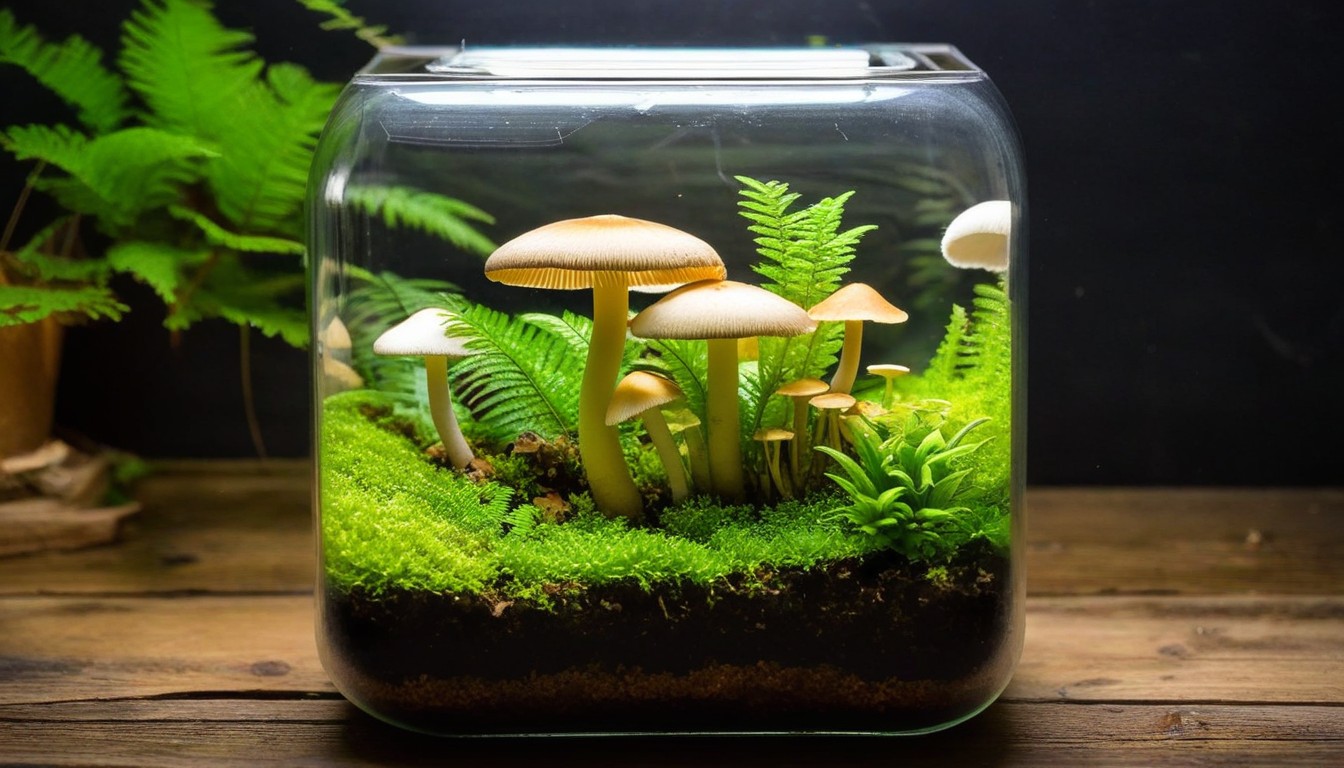
Congratulations, you’ve successfully grown your own mushrooms! It’s time to enjoy the delicious flavors of your hard work. Here’s how to harvest your mushrooms:
- Wait until the caps of your mushrooms have fully opened and flattened out.
- Gently twist and pull the stem of the mushroom to detach it from the substrate.
- Handle your mushrooms delicately to avoid bruising or damaging them.
- Store your harvested mushrooms in a paper bag in the refrigerator for up to five days.
It’s important to know that you should never wash your mushrooms. A quick wipe with a damp paper towel is all that’s needed to remove any dirt or debris. Washing your mushrooms can cause them to become waterlogged and lose flavor.
Pro Tip: Try sautéing your fresh mushrooms with garlic and butter for a delicious and simple side dish.
Enjoying the Fruits of Your Labor
Now that you’ve harvested your mushrooms, it’s time to enjoy them! Here are some tasty ways to prepare your homegrown fungi:
|
Recipe |
Description |
|---|---|
|
Mushroom Risotto |
A creamy and flavorful rice dish with sautéed mushrooms. |
|
Mushroom Soup |
A warm and comforting soup made with fresh mushrooms and herbs. |
|
Delicious mushroom caps filled with a savory stuffing of your choice. |
Experiment with different recipes and enjoy the unique flavors of your homegrown mushrooms.
Remember, always be sure to properly identify your mushrooms before consuming them and consult with a healthcare professional if you experience any adverse reactions.
Conclusion
In conclusion, growing mushrooms in a terrarium can be a fun and rewarding indoor gardening project. By following the steps outlined in this guide, you can create the perfect growing environment for your chosen mushroom species and enjoy the fruits of your labor.
Remember to choose the right terrarium for your mushrooms, select a suitable mushroom species, provide the perfect growing environment, prepare the substrate correctly, and maintain and care for your terrarium to ensure healthy growth. With patience and attention to detail, you can harvest your very own homegrown mushrooms!
Get Started Today
Don’t wait any longer to start your mushroom cultivation journey. Spend some time researching and gathering the necessary supplies, and then dive right in. Whether you’re looking for a fun hobby or a new addition to your indoor garden, growing mushrooms in a terrarium is a unique and exciting project that is sure to bring you hours of enjoyment. Happy growing!
FAQ
What are some common types of terrariums for growing mushrooms?
Common types of terrariums for growing mushrooms include glass jars, plastic containers, and specially designed mushroom grow kits.
Can I use any mushroom species in a terrarium?
Not all mushroom species thrive in terrariums. It’s important to select species that are well-suited for indoor cultivation and consider factors such as temperature, humidity, and lighting requirements.
How can I create the ideal growing environment in my terrarium?
To create the ideal growing environment, you need to maintain optimal conditions in terms of temperature, humidity, and ventilation. This can be achieved through proper monitoring and adjustments as needed.
What materials should I use to prepare the substrate?
Common materials for preparing the substrate include straw, wood chips, and sawdust. It’s important to properly sterilize the substrate to prevent contamination and ensure a healthy growing medium.
How do I inoculate my terrarium with mushroom spores?
Inoculation can be done using methods such as spore syringe injection or spore print transfer. Following proper sterilization techniques and following specific instructions for your chosen method is crucial for successful colonization of the substrate.
How do I maintain and care for my mushroom terrarium?
Regular tasks for maintaining and caring for your mushroom terrarium include watering, misting to maintain humidity, and monitoring for signs of contamination or pests. Prompt action should be taken if any issues arise.
When should I harvest my homegrown mushrooms?
The timing of mushroom harvest depends on the specific species. Generally, it’s best to harvest when the mushrooms have fully matured but before they release spores. Additionally, following proper harvesting techniques ensures the highest quality and flavor.

